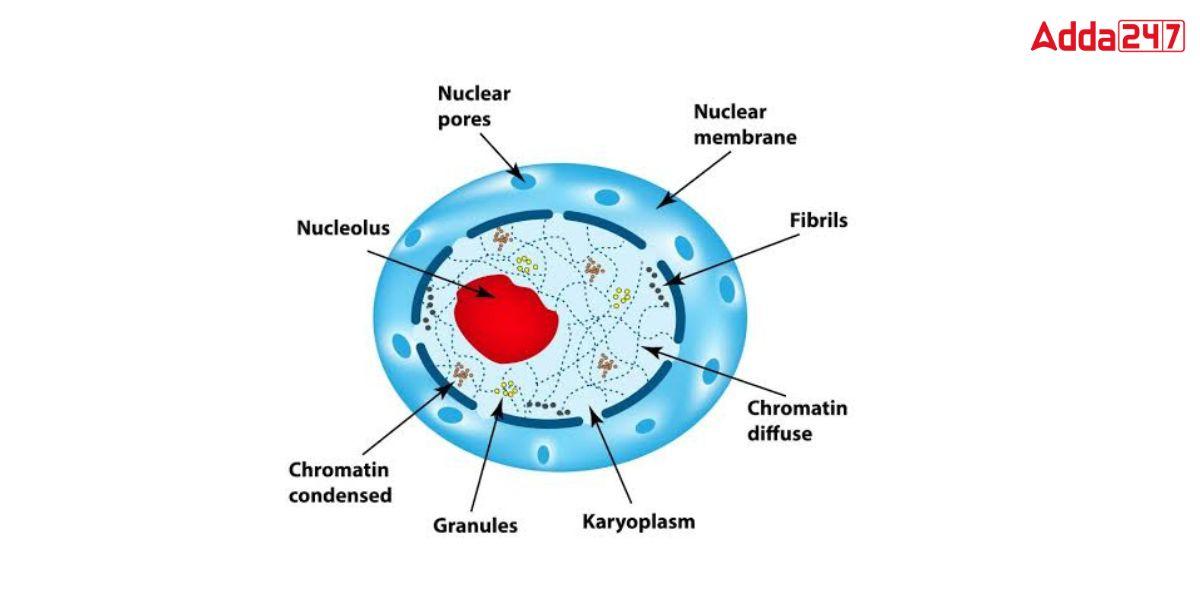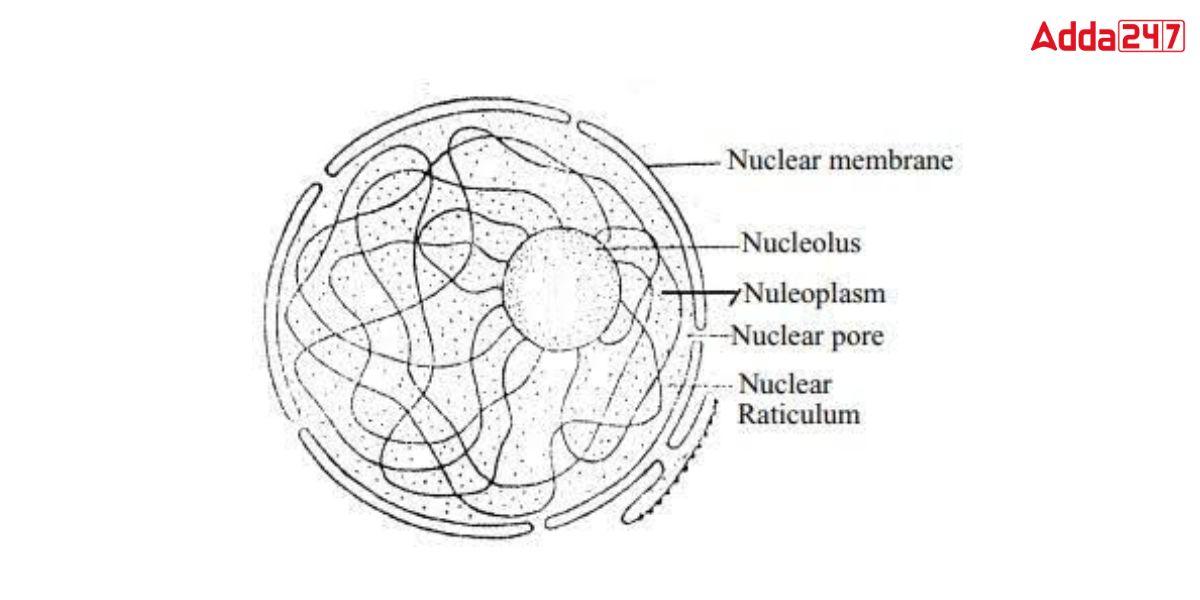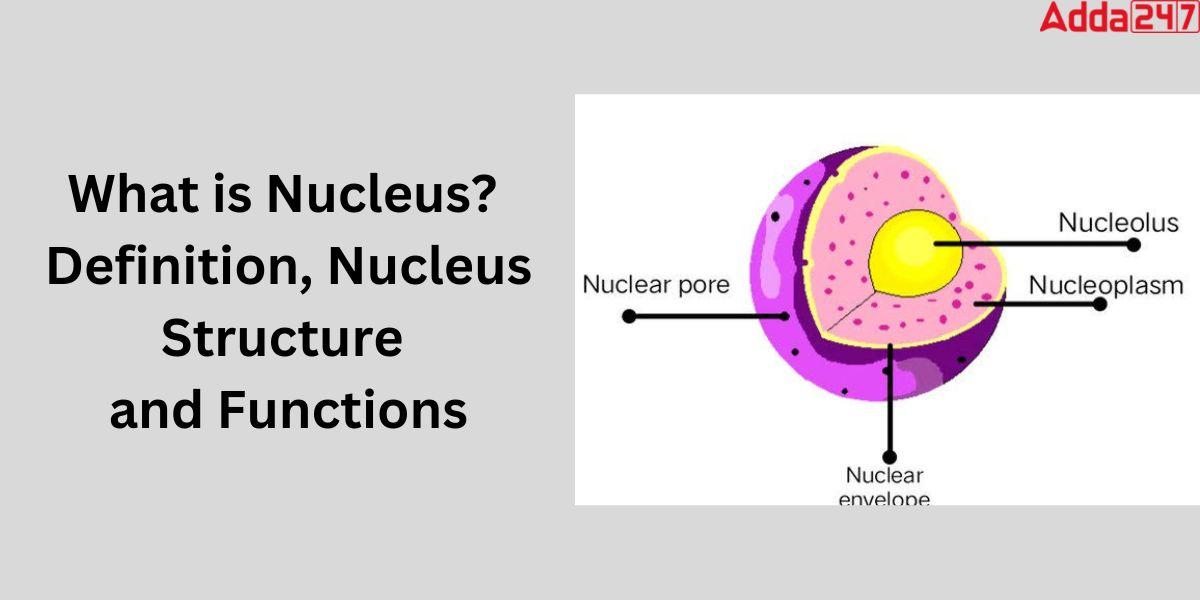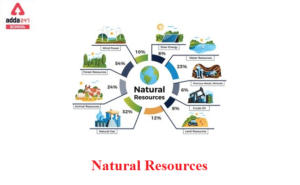Table of Contents
The nucleus is the most integral component of the cell. A nucleus is a double-membraned organelle that serves as the cell’s command center. The cell nucleus stores hereditary information and regulates development and reproduction. In this article, we will learn more about the nucleus, its diagram, features, and functions.
What is Nucleus?
In biology, the nucleus is a specialized structure found across most cells (excluding bacteria and blue-green algae) that is separated from the rest of the cell by a dual layer known as the nuclear membrane. This membrane appears to be continuous with the cell’s endoplasmic reticulum (a membranous network) and has pores that likely allow large molecules to enter. The nucleus regulates the cell’s activities (for example, growth and metabolism) and houses the genes, which contain hereditary information. Nucleoli are small bodies that are frequently seen within the nucleus. The nucleoplasm is the gel-like matrix in which the nuclear components are suspended.
Nucleus Diagram
The nucleus Diagram is given below. check the Diagram of the Nucleus here.

Describe the Function of Nucleus
The nucleus is a membrane-bound organelle found in eukaryotic cells, and it serves several important functions:
Storage and Protection of DNA: The primary function of the nucleus is to store and protect the cell’s genetic material, which is in the form of DNA (deoxyribonucleic acid). DNA contains the instructions for making all the proteins and molecules necessary for the cell’s structure and function.
Transcription: Within the nucleus, DNA is transcribed into RNA (ribonucleic acid) in a process called transcription. RNA serves as a template for protein synthesis. Various types of RNA, such as messenger RNA (mRNA), ribosomal RNA (rRNA), and transfer RNA (tRNA), are synthesized in the nucleus.
Regulation of Gene Expression: The nucleus plays a crucial role in regulating gene expression. This means it controls which genes are turned on (expressed) and which are turned off (repressed) at any given time. Gene expression regulation is vital for cell specialization and responding to environmental changes.
Ribosome Production: The nucleolus, a substructure within the nucleus, is responsible for producing ribosomal RNA (rRNA) and assembling ribosomes. Ribosomes are the cellular machinery responsible for protein synthesis.
Nuclear Pore Complexes: The nuclear envelope, a double membrane that surrounds the nucleus, contains nuclear pore complexes. These complexes allow the controlled exchange of molecules (such as RNA and proteins) between the nucleus and the cytoplasm while preventing the unregulated passage of large molecules.
Cell Cycle Control: The nucleus also plays a role in cell cycle regulation. It controls the initiation and progression of the cell cycle, including processes like DNA replication, mitosis, and cytokinesis.
Storage of Genetic Information: In addition to DNA, the nucleus may also store other genetic elements, such as histones and regulatory proteins, which help package and regulate the DNA.
Response to Cellular Stress: The nucleus can respond to various cellular stresses, such as DNA damage, by initiating repair mechanisms or, in some cases, triggering programmed cell death (apoptosis) to eliminate cells that cannot be repaired.
In summary, the nucleus is a critical organelle responsible for the storage, protection, and regulation of genetic information, as well as for controlling various cellular processes that are essential for the proper functioning and survival of eukaryotic cells.
Cell Nucleus
The cell nucleus is the most visible organelle within a eukaryotic cell, and it is possibly the most important and distinguishing feature of eukaryotic cells. The nucleus contains the majority of the genetic material (DNA), with only a small amount found in mitochondria. The majority of human cells have a single nucleus, though some cell types have multiple nuclei (e.g., osteoclasts) or no nucleus at all (erythrocytes). Because the structure of the nucleus is an important milestone in understanding cytology and histology, continue reading to learn more about the nucleus.
Diagram of Cell Nucleus
Diagram of Cell Nucleus is given below.

Nucleus Structure
The nucleus of a cell is made up of nuclear envelope, nucleoplasm, nucleolus, and chromosomes. Nucleoplasm. The major elements of the nuclear structure are mentioned below:
- Nucleoplasm
The nucleoplasm is the major centre of the cell where the genetic material is found. In the electron microscope, its outline is frequently irregular, which is apparently determined, at least in part, by the existence of transcripts at the interface of nucleoplasm and cytoplasm. Because they are excluded from the DNA-rich region, proteins involved in DNA compaction, replication, and transcription are most likely at the nucleoplasm’s periphery. Whereas nucleoplasm refers to a microscopically visible area of the cell, a nucleoid or bacterial chromosome is a separate entity that can be isolated or genetically analysed.
- Nuclear envelope
The nuclear envelope, also known as the nuclear membrane, is a double membrane layer that segregates the nucleus’ contents from the rest of the cell. It can be found in animal and plant cells. A cell performs numerous functions, including protein synthesis, molecule conversion to energy, and waste removal. The nuclear envelope shields the genetic material of the cell from the biochemical processes outside the nucleus. It also contains many proteins that are involved in the organisation of DNA and the regulation of genes.
- Chromatin
Chromatin is a genetic material or macromolecule that consists of DNA, RNA, and associated proteins that form chromosomes in the nucleus of eukaryotic cells.
This chromatin is found in the nucleus of the cell. This genetic material’s main functions include: preventing DNA damage, tightly carrying the DNA to fit into the cell, controlling DNA replication and gene expression, and many others.
Chromatin is a highly organised complex of DNA and proteins that is found in the nucleus of cells. Histone proteins aid in the organisation of DNA into structural units known as nucleosomes, which are then compiled into a compact structure known as chromatin and, eventually, very large, high-order structures known as chromosomes. Post-translational modifications of histone proteins and DNA, which have profound impacts on the regulation of chromatin structure, binding of chromatin-modifying complexes, and transcription factors regulators, greatly influence the localised accessibility of chromatin.
- Nucleo pores
A nucleopore is one of several openings in the nuclear membrane of a cell. Nucleopores are channels that allow nucleic acids and proteins to be selectively transported into and out of the cell nucleus. Nuclear membrane nucleopores control the dynamic process of protein and nucleic acid transport into and out of the nucleus. The transport of messenger RNAs, a type of nucleic acid that is transcribed from genes in the nucleus and then transmitted to the cytoplasm via nucleopores, is a good example of this. They are translated into proteins once they reach the cytoplasm. In the opposite direction, proteins that reside in the cytoplasm until activated by chemicals such as hormones can be signalled to enter the nucleus via nucleopores.
Cell nucleus chromosome DNA gene
-
Chromosome
Chromosomes are threadlike structures composed of protein and an only one molecule of DNA that transport genomic information from cell to cell in the nucleus. Chromosomes are found in the nucleus of cells in plants, animals, and humans. Humans have 46 chromosomes in total, with 22 pairs of numbered chromosomes called autosomes and one pair of sex chromosomes – XX or XY. Each pair has two chromosomes, one from each parent, so children will inherit half of their chromosomes from their own mother and half from their father. When the nucleus diffuses during cell division, chromosomes can be seen under a microscope.
-
Gene
Genes are the foundation of your body. Some genes encode instructions for the production of proteins. A protein’s function is to inform your body what physical characteristics, such as hair and eye colour, you should have. Some genes encode for RNA, which performs additional functions. Your genes are passed down from your parents. Each parent gives you one copy of a gene, one from the egg and one from the sperm. Once you receive a pair, your genes divide and replicate until your body has enough genes to satisfy your instruction manual. Your body contains between 20,000 and 25,000 genes.
-
DNA
Deoxyribonucleic acid (DNA) is the component present in every cell’s nucleus that contains your genetic code. It is the instruction manual for your body.
DNA uses a language/code to create your instruction manual. Your DNA language is made up of four chemical bases: Adenine (A), Cytosine (C), Thymine (T), and Guanine (G). These four bases are arranged in order to form a specific code in which an instruction will be used. DNA is constantly replicating itself by copying your body’s instruction manual using the portions of bases that form the codes. A human body contains an estimated 3 billion bases. Approximately 99% of those bases are shared by all people. The remaining 1% is what distinguishes you.
The connection between genes, DNA, and chromosomes
DNA, genes, and chromosomes all work together to shape your body and personality. In cells, chromosomes translocate DNA. DNA is in charge of creating and keeping your human structure. Genes are DNA segments that convey you physical traits that make you exceptional. Your body has a precise instruction manual that instructs your cells on how to behave.
Cell Nucleus Structure and Function
The nucleus plays many vital key roles in a Living cell.The crucial roles that the nucleus plays are listed below.
- It stores the cell’s genetic blueprint in the form of deoxyribonucleic acid (DNA) or chromosomes and thus regulates cell growth and multiplication. It also serves as a site for DNA replication (creation of an identical copy of DNA).
- It controls cell metabolism by synthesising a variety of enzymes.
- The nucleus is a transcriptional site where messenger RNA for protein synthesis is produced.
- The nucleus exchanges hereditary molecules, RNA and DNA, between the nucleus and the rest of the cell.
- During cell division, chromatins in the nucleus are organised into chromosomes.
- It is involved in the nucleolus’ ribosome production.
- The nucleus transports regulatory elements and energy molecules selectively through nuclear pores.


 Types of Natural Resources with Examples
Types of Natural Resources with Examples
 All 100 Birds Name in Hindi and English
All 100 Birds Name in Hindi and English
 50 Water, Aquatic, Ocean, Sea Animals Na...
50 Water, Aquatic, Ocean, Sea Animals Na...














